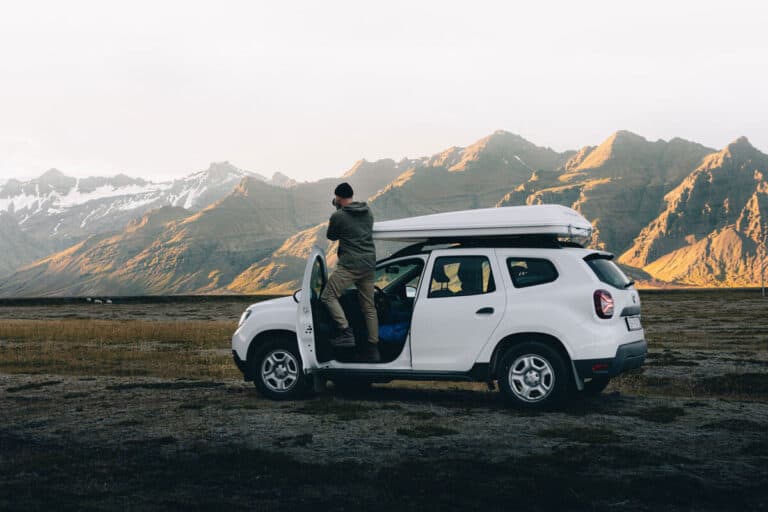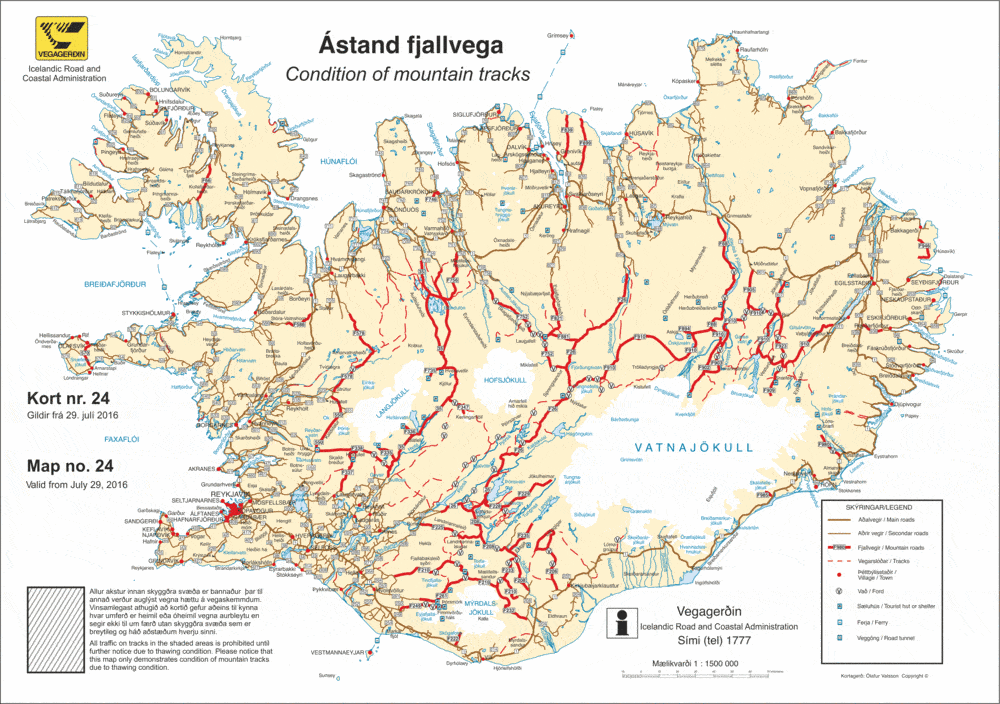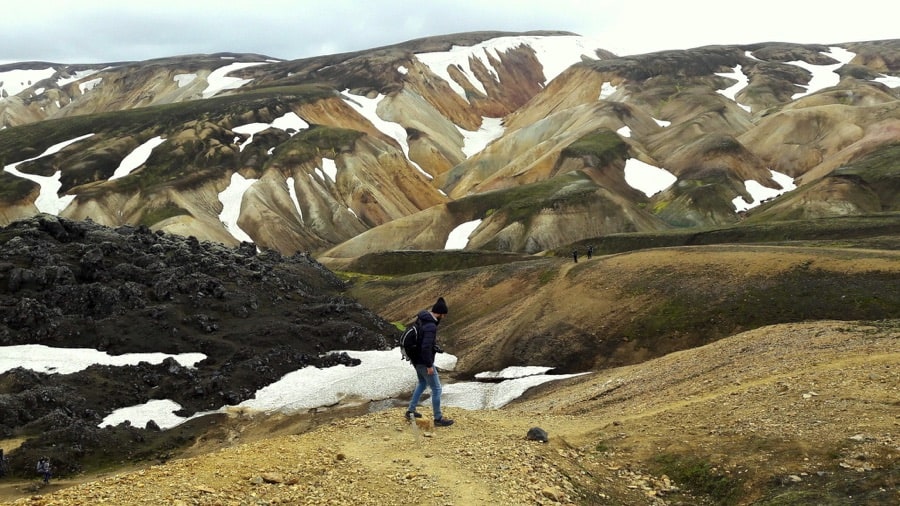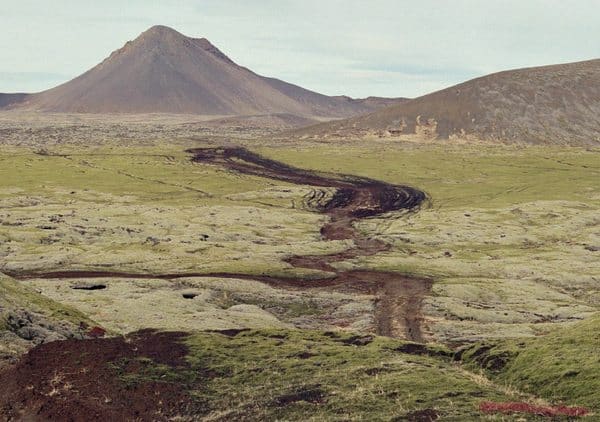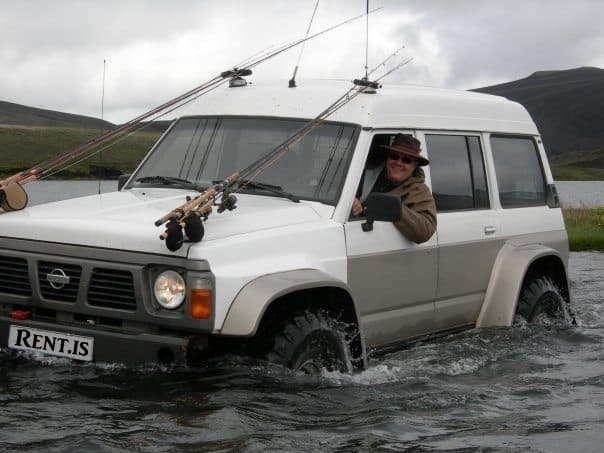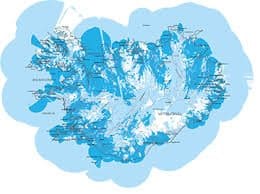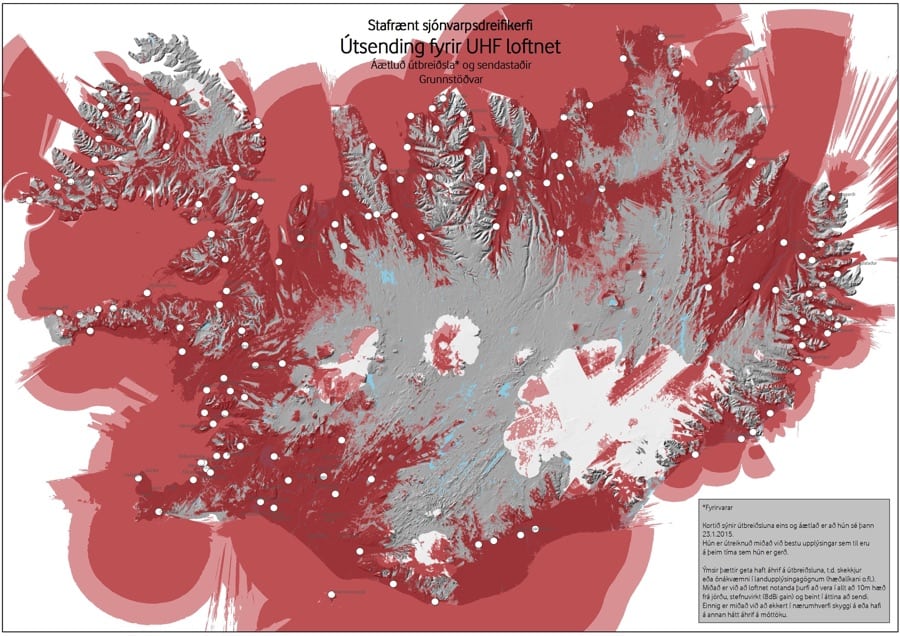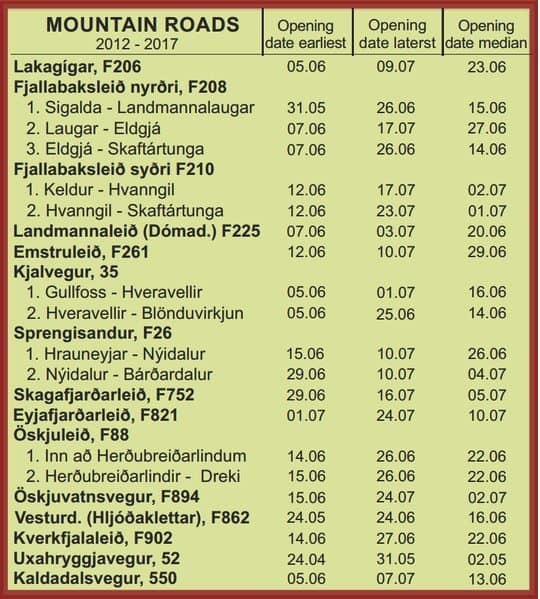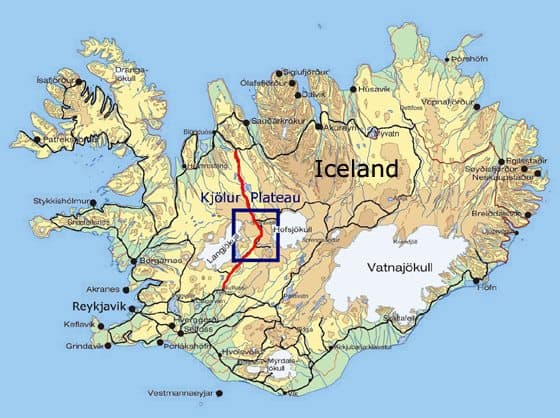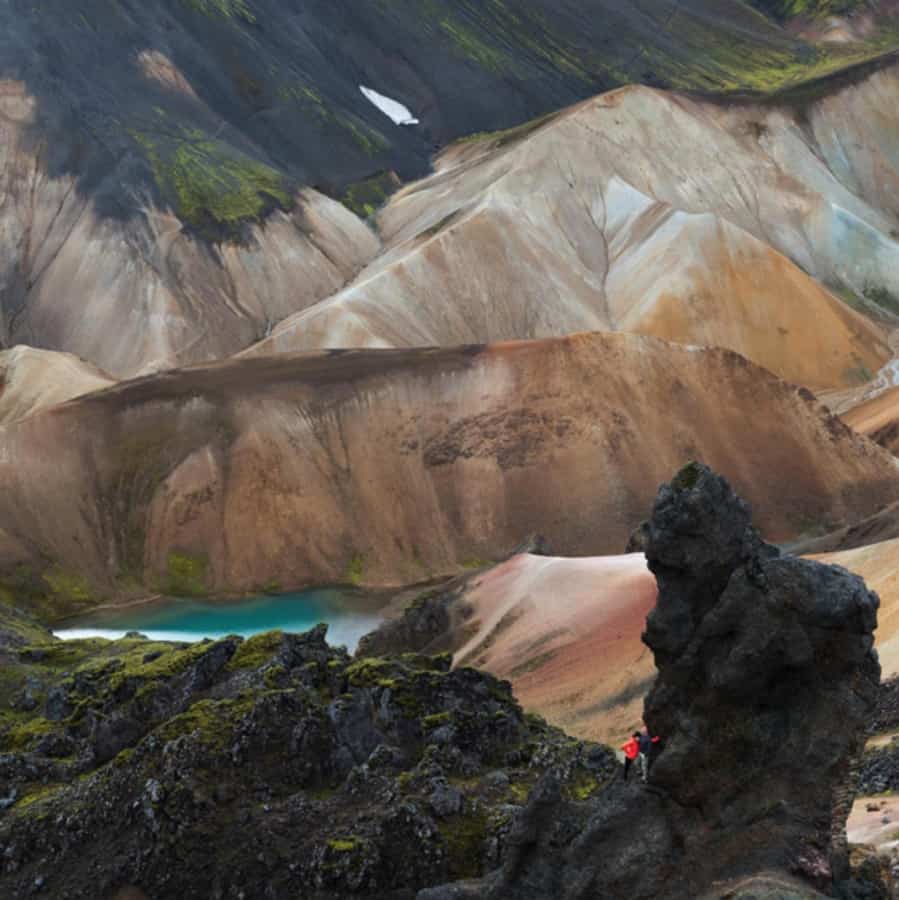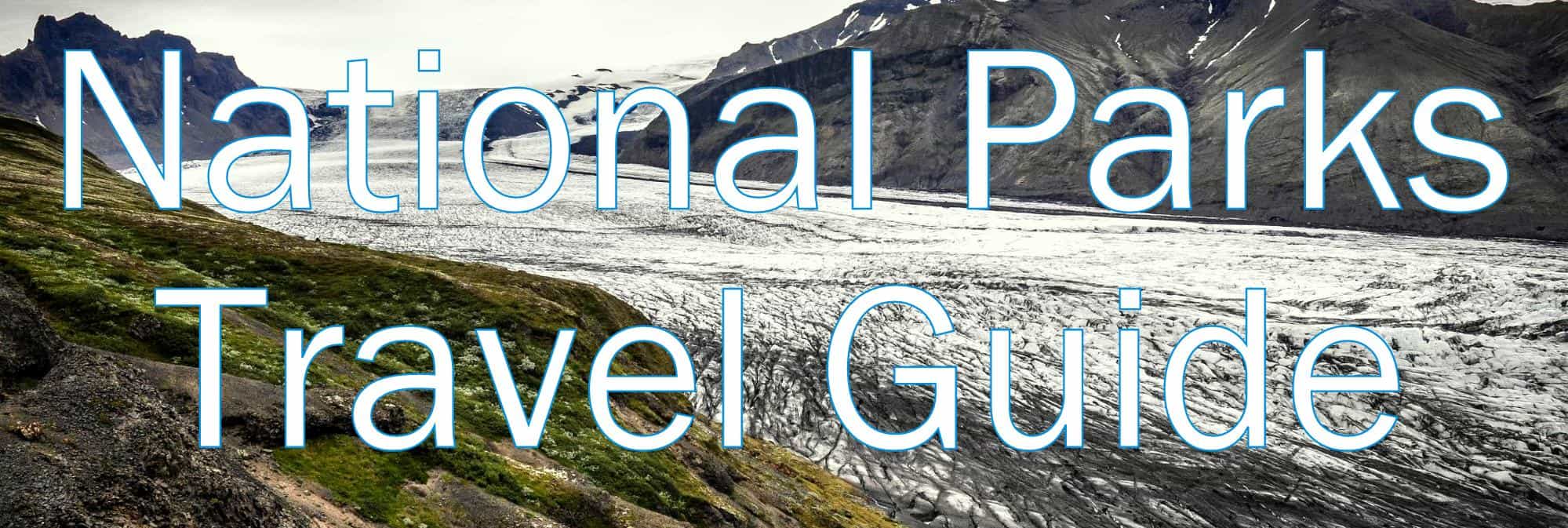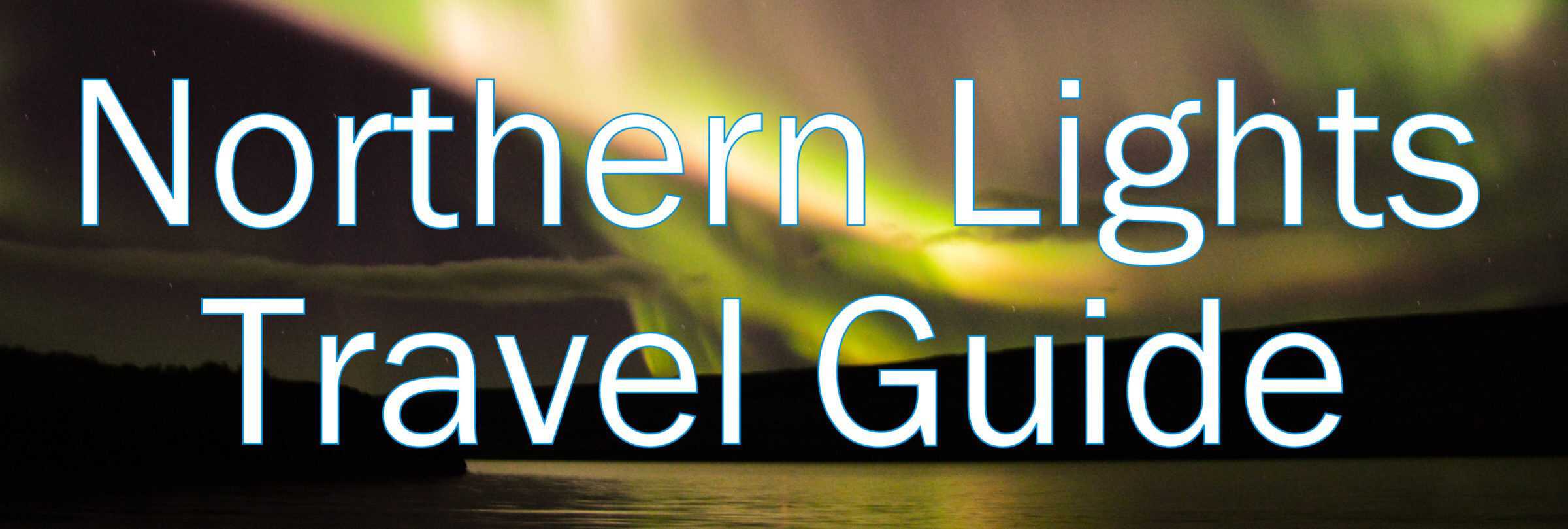With the addition of our 4×4 camper van rental, exploring the Highlands in Iceland is now possible. With that option, a whole new side of Iceland is open for exploration of the Icelandic interior.
So, where are the Highlands in Iceland? They stretch across the country’s rugged interior, away from the coast and Ring Road, accessible only by seasonal F-roads. A trip here wasn’t possible with our standard camper vans, but with a 4×4 — which is a must for anyone renting a camper in Iceland — you can venture well off the beaten path and experience landscapes unlike anywhere else.
But with the increased freedom comes an increased responsibility too. There are many factors to take into consideration to make your trip as safe and comfortable as possible.
Click on the map to get a PDF file with the latest information
Test yourself: Take our Iceland Quiz!
Highland population
Nobody really lives up in the Highlands of Iceland. There are people who work up there, road workers, reservoir builders, people doing maintenance on the power grid and service centers for tourism but those are very few and they are very far between. There are no gas stations up there except for in the outskirts of the Highlands. In the middle, there is no place where one can seek immediate help in times of need. But the desolation is something to embrace, to be in really wild nature where there is nothing but you and endless beauty.
 Off-road driving
Off-road driving
As wild, majestic and wonderful as the Icelandic Highlands are, we really want to keep it that way. Driving off-road is strictly forbidden, for all cars and trucks. Being caught driving off-road can result in very hefty fines. Because it’s so harsh up there, the little growth you’ll find there has taken decades to grow and a car tire can kill the plant and not to mention, tire tracks might be seen for decades to come so, leave the Highlands as you find it. Majestic and unspoiled. The same goes with any trash (never litter—anywhere), it takes ages for any trash to decompose due to the average low temperatures.
 Fording rivers
Fording rivers
As fun and adventurous as it looks to ford rivers, there is one thing one has to keep in mind. Insurance does not cover damages to the car like flooding the engine, water destroying electronics, the cost of the rescue etc caused by river crossings.
In the Highlands there are quite a few spots requiring river crossing. Many of these are not deeper than you can walk over them in your slippers. Others are raging rivers with hidden depths and currents, requiring special knowledge and experience to cross in super jeeps designed to do just that.
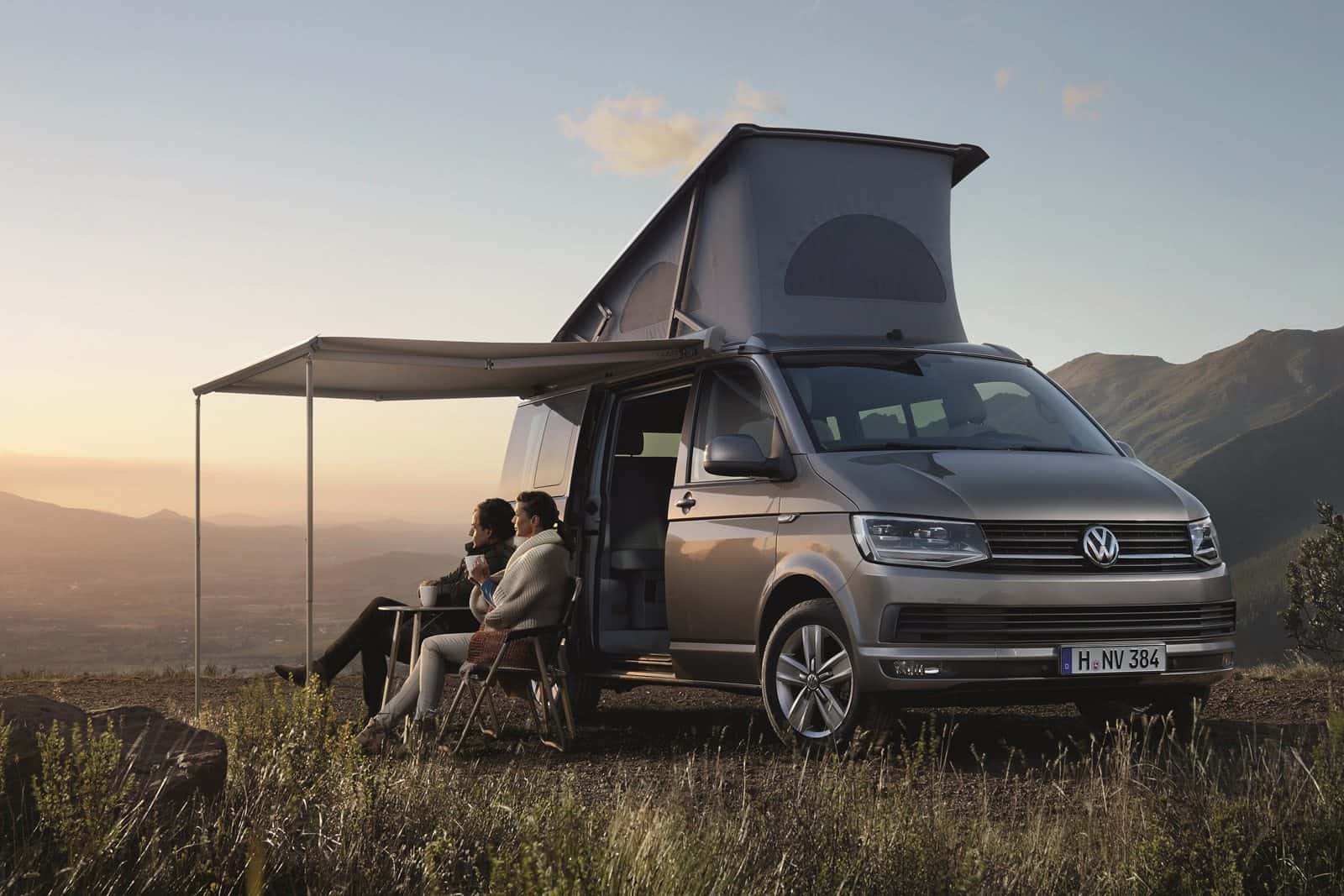 If you find yourself in front of a river and you take it upon yourself to cross (remember no insurance covers any possible damage), you have to be smart about it. The one thing you do NOT do is to take chances for that may cost you dearly. If you are insecure of what is in front of you, wait for others to join you (if there are others driving that stretch of road you are on) and let more experienced drivers show you the way, if there is a way over. Tell tale signs are tire tracks on both sides of the river. You might see where cars enter the river and where they exit but keep in mind that the tracks might have been caused only by super jeeps and not ordinary 4×4’s. If the water is crystal clear, you see much better what’s ahead.
If you find yourself in front of a river and you take it upon yourself to cross (remember no insurance covers any possible damage), you have to be smart about it. The one thing you do NOT do is to take chances for that may cost you dearly. If you are insecure of what is in front of you, wait for others to join you (if there are others driving that stretch of road you are on) and let more experienced drivers show you the way, if there is a way over. Tell tale signs are tire tracks on both sides of the river. You might see where cars enter the river and where they exit but keep in mind that the tracks might have been caused only by super jeeps and not ordinary 4×4’s. If the water is crystal clear, you see much better what’s ahead.
Take off your shoes and wade the river to see what’s ahead (it will be cold). Cold feet are a small price to pay for a safe passage. If you are unsure in any way, turn around and find another road. If you are sure the river is no more than ankle deep and you are going to ford the river, make sure your car is in 4×4 mode before entering. When crossing, keep your crawl speed in a low gear, do not brake, do not change gear, stop to look around, just drive over at a steady pace. Start where others have entered and drive out of the river where you see, if you see signs of others have done it before you. When safely on the other side, don’t stop the engine to have a look around. Let the engine run if you do stop, just to make sure any intruding water may evaporate from the engine heat. The decision to ford a river, do not take it lightly and remember, you are all on your own with that.
Cellphone coverage in the Highlands
The maps below show the cellphone coverage from the two biggest phone companies in Iceland. The Highlands often have little to no signal, so it’s essential to plan ahead. The gray areas (the light blue on the map to the left) show where there is no coverage at all.
With this knowledge, one has to have that in mind before venturing across a river for if you find yourself in deep trouble, rescue might be far away. To minimize the risk of being stranded for a long time, plan your route, do your research before crossing the Highlands. When you have your plan, stick to the plan and let people know of your plan. Let the hotel you are leaving know your route and if possible, the hotel you are aiming for know your ETA. The most valuable help you can get is to let the guys at Safe Travel have your travel plan. On their front page, you just have to fill in your information with dates, route, times and such. When you have done that, you have added invaluable security to your trip. You should also download their 112 app (911) for added security.
If you have an accident, a breakdown and no cellphone coverage at all, keep in mind that if you don’t have coverage, the search and rescue people have cell phone receivers mounted on helicopters so they can still find you easily if you have filled in your travel plans and you have your cellphone on. Here is what the SafeTravel people say about the app:
Brilliant hey?
There are Windows and iPhone versions of the 112 app. (rated 4.6)
 F-roads
F-roads
More or less all roads in the Highlands are marked F-roads. An F-road can be anything from a smooth, unpaved road to washboard gravel to seriously rocky roads with parts washed away and deep pot holes everywhere. F-roads are not open year-around. The chart to the left gives you an idea when the different F-roads open up but to get the latest information, call road.is at +354-522-1100.
Driving 50 km on the Ring Road will take you maybe 45 minutes. Driving 50km on an F-road can take you the better part of a day, depending on the state of the road and not to forget the weather. The loose gravel, uneven terrain and proximity to active volcanoes like Hekla volcano make cautious driving essential, especially in the Southern Highlands.
As you might know already, the weather in Iceland can change in an instant and in the Highlands even, more so. When planning a trip over the Highlands, you do not only need to have the latest information about the roads you will be driving, you also need to know what kind of weather might be expected. If heavy rain is expected, some roads might get flushed due to runoffs. Some places where you planned to ford a river might be a torrential river running way too deep and hard for any vehicle to pass. You also have to keep in mind if heavy rain in other areas will affect the depth of rivers where you are planning to cross.
 Kjalvegur – F35
Kjalvegur – F35
There is one main route most people choose when driving across the Highlands. Kjalvegur is the name of it. Its number is F35. Kjölur is a plateau in the Highlands, roughly defined as the area between the glaciers Langjökull and Hofsjökull at an altitude of about 600–700 metres. Kjalvegur cuts through this area. It’s also a very historic route for it is mentioned in the old Icelandic sagas where it was used during summer to connect the different areas in the north and south.
Kjalvegur (F35) continues north from Gullfoss to the junction north of Blönduós (about 168 km / 104 miles). Roughly a third of the way, a short detour leads to Hveravellir, one of the few places in the Highlands with facilities (hot spring, showers, simple dining, camping). No fuel is available there. There is even a horse rental up there. When arriving on the north side, you will either come down close to Blönduós or Varmahlíð, depending on which route you choose after the reservoir Blöndulón.
Sprengisandsleið – F26
This F-road goes between the glaciers Hofsjökull and Vatnajökull. It’s a very scenic road but unfortunately, it’s totally impassable for any vehicles other than super jeeps and the huge tour buses that drive from Landmannalaugar to Mývatn every second day during high season.
In certain areas near Vatnajökull National Park, adventurers can explore ice caves, beautiful mountains and active geothermal zones.
Sand, dust and ash storms
The Highlands are very dry when it’s not raining of course. So you need to prepare yourself for a lot of dust during the driest periods. If or when you meet other cars up there, slow down more than usual for both cars are ripping up dust and not to mention stones. Very dusty roads can be very slippery and under the dust, knife-sharp stones waiting to rip your tires to shreds so drive slowly and keep your eyes on the roads at all times.
Sand and dust storms do happen up there and they can be very thick. To be covered for any damages by sand, ash and gravel, you need to have purchased the sand and ash protection (SAAP) insurance or the premium (PiP) to lower your self risk. Without it, you might end up paying the full cost for damages. This is not a sales pitch. The Highlands are absolutely stunning but it can also wreak havoc on your car, the paint job and the underbody. It should also be noted that no insurance covers (goes for all camper & car rental companies here) damages to the underbody which one has to keep in mind when driving rougher parts of any F-roads. The same goes for tires so do drive with extra care up there.
Camping in the Highlands
Spending nights up in the Highlands (which can only be done during summer) is a thrilling experience for many reasons. Just by entering the Highlands, you have already left the big crowds behind you so you will have all the solitude you want with views over vast expanses. As mentioned before, all driving off-road is strictly forbidden but there will be plenty of gorgeous places where you can camp for the night. The same rules apply as when camping anywhere outside a designated camping site. You may not camp on private grounds which are fenced in. Not many of those up there. When parking your 4×4 camper, make sure you pose no danger at all to any other vehicles. There can be very violent winds up there so take extra care when opening the doors and only one at a time if there are strong winds present. Try to find a place where there is some protection from the winds.
 When you need to “do your business”, dig a hole and fill the hole when you are done. All trash needs to be disposed of in garbage bins. In areas where inhabitants are scattered over a wide expanse, you might come across trash containers where you can safely dispose of your trash. If you don’t pass one while driving down, dispose of the trash in the next village or rest stop (if there are garbage bins there).
When you need to “do your business”, dig a hole and fill the hole when you are done. All trash needs to be disposed of in garbage bins. In areas where inhabitants are scattered over a wide expanse, you might come across trash containers where you can safely dispose of your trash. If you don’t pass one while driving down, dispose of the trash in the next village or rest stop (if there are garbage bins there).
You can drink any clear water you see. It will be very clean as long as there is no milky coloring in it. The milky colors means that it is melting water from a glacier and you should never drink that.
Conclusion
Driving in the Highlands is a very exclusive trip where one can experience the remote interior of Iceland but remember to plan, do research, fill in your details with Safe travel before going on a journey and keep to your plan, for your own safety. You don’t want to get stuck up there for days on end but you don’t want a search and rescue party to go looking for you unnecessarily. If possible, travel with one or two other cars. Driving there requires extra attention to roads and weather and never taking any chances. Don’t leave any track of your stay in the Highlands but foremost, be ready to have your mind blown by eternal beauty, vast landscapes in one of Europe’s wildest, least-populated regions.
Happy Camping! #WohoCamper
Iceland Travel Guides
If you like what you see, please subscribe to our YouTube channel!

